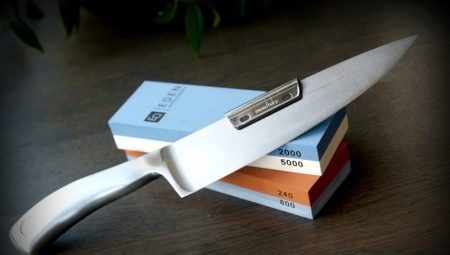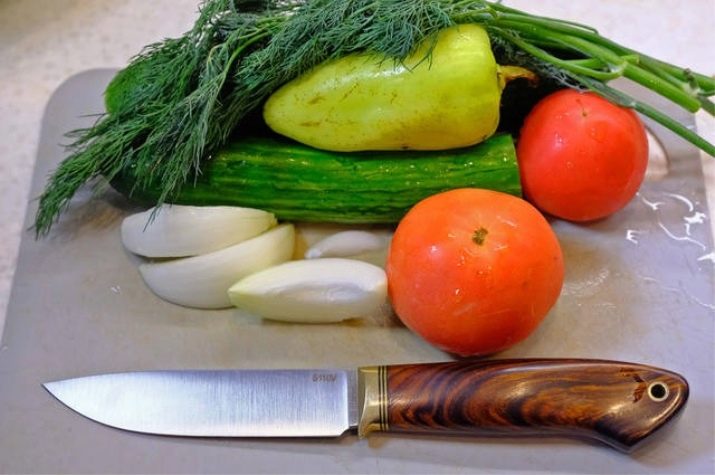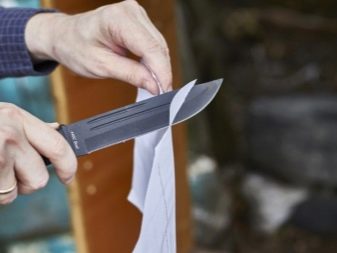How to sharpen knives correctly at home?

Many housewives complain that the knives remain dull even after they have been sharpened. This is because the process was not completed correctly.

Types of edge processing
If we talk about knives, then this is a fairly ancient object that has not changed its basic shape for many centuries. They consist of a very comfortable handle, as well as a blade that must be sharp. Their edges are made from different types of alloys, for which different methods are used.
- Carbon steel knives are affordable for anyone. They are made from an alloy of iron with carbon itself. They remain sharp for a long time, and after they become dull, they can be sharpened quite easily. But these knives also have some drawbacks. At the slightest contact with any acidic environment, they begin to rust. Accordingly, food that was cut with such a knife also gives off a metallic taste.
- Stainless mild steel knives. For the manufacture of such an edge, methods of alloying iron with carbon, as well as with the addition of elements such as molybdenum, chromium, and nickel, are used. Such knives require very frequent sharpening, however, they do not corrode.
- Knives that are made of stainless high carbon steel do not need to be sharpened too often. In addition, they are completely unaffected by corrosion. Their alloy contains a lot of carbon, as well as vanadium and cobalt.
- The edge of knives, which are made of Damascus steel, is most often used to create edged weapons.But in domestic conditions, they are quite rare. Only high quality alloys are used for their manufacture. If we talk about the shortcomings, then this is only their high price.
- Knives with ceramic blades are distinguished by their sharpness, which lasts for quite a long time. You don't have to sharpen them for a couple of years. Their only drawback is their great fragility.



Which knives cannot be sharpened at home?
You shouldn't start learning how to sharpen knives by experimenting with your favorite knives. After all, a few incorrect movements are enough and the instrument can be damaged. Ceramic knives can only be sharpened with a diamond stone. If he is not in the house, then it is best to contact a specialist who can do it professionally.
Besides, do not sharpen knives made of damascus steel... After all, this is a rather difficult and long business. Therefore, not every person will be able to cope with such a task.
Those knives that have a wavy blade also do not need to be sharpened at home. In addition, you should not carry them to the master. After all, it is practically impossible for them to return to their previous appearance.



Sharpening tools
Knives dull quickly enough if they come into contact with a very hard surface. In addition, those who use them on a daily basis for slicing meat also have to tidy up the blade on a regular basis. There are many tools available for this process. It can be ordinary sandpaper, and a whetstone, as well as any means at hand.
Electric sharpener
Such a tool is good because it can be used to sharpen knives quickly enough. Moreover, this is done automatically. However, this removes too much steel, which will cause the blade to wear off quickly. Therefore, always have a cold liquid on hand so that you can quickly cool the heated blade. In addition, it is almost impossible to sharpen a knife equally on both sides.

Musat
Using such a tool, you cannot sharpen a knife that is too dull, because it is used more for dressing, and not for sharpening. In addition, literally in a few days, the knife will again be dull.

Roller knife
This option is considered the best option for women. It is enough to run the knife several times over the rollers, and it will be sharp. Anyone can buy such a little knife, since it costs very little.

Sandpaper
Many people are very skeptical about this way of turning. However, those who have already tried such a remedy are convinced that this is a completely acceptable option. Of course, it is not very convenient, but if necessary, it will help to sharpen the knife.

Ceramic bar
This is one of the cheapest tools you can buy at home to keep your knives sharp without any problems. The only thing is to choose it correctly. It is best to buy two bars at once. One of them will have a rougher surface and will be used for basic turning as well as blade angle correction. The second most often polished surface.
The length of the bar should be at least the length of the knife itself. In addition, the wider its surface is, the more comfortable it will be. This sharpening option requires a lot of patience from a person, because it will be difficult to cope with this process too quickly.

Diamond circles or stones
The price of such instruments is high, however, the result is worth it. In addition, it is more comfortable to work with him. The base of these tools is made of plastic or aluminum. Diamond-coated metal plates are fixed on it. Such sharpeners do not grind for a long time, and even after a few years they will look the same.
In addition, such tools have many advantages:
- do not break even when they are simply dropped to the floor;
- do not clog when sharpening;
- quickly cope with the task.
The disadvantages include their high price.

Japanese water stones
These are the same bars that must be used not in a dry state, but moistened in water.But the price for them is too high, but they wear out quickly. Therefore, it is better not to use them for sharpening kitchen knives.

Emery
Such a tool is more suitable for craftsmen than for beginners. With its help, you can make a knife blade sharp in just a few seconds.

Selecting and setting an angle
Whichever tool is chosen, there will always be approximately one sharpening technology. First you need to practice on the simplest and cheapest bar, and then you can buy tools a little more expensive.
However, in any sharpening process, the sharpening angle must be set correctly. If we talk about kitchen knives, then it should be from 20 to 40 degrees. In addition, you need to know that the smaller the sharpening angle, the thinner the knife blade will be. But it will not be sharp for long, in addition, when it touches any hard surface, the blade will lose its shape.
Therefore, it is necessary to choose the direction of the sharpening angle depending on what needs to be cut. So, professional knives should be sharpened at an angle of 20 to 30 degrees, but household knives - from 25 to 35 degrees. For Japanese kitchen knives, the sharpening angle should be between 15 and 20 degrees.


Step-by-step instruction
In order to learn how to sharpen kitchen knives correctly with your own hands, you need to read the step-by-step instructions. In addition, it is simple and quick to do it at home. However, here you need to know that there are editing and sharpening. For the first, you can use musat, sandpaper or a ceramic plate. For the second, tools such as a sharpener, a block, diamond or electric sharpeners are suitable.
Manual sharpening with a regular bar
- First you need to place the block so that it is convenient to sharpen the knives. In addition, you need to put any tea towel under the block so that it does not slide over the surface. The block should lie, you should not hold it in your hands, since in this case it will be impossible to control the sharpening angle.
- Next, you need to put the knife across the bar and make movements to the side from you. This should be done as if a regular pencil is being sharpened. In addition, you do not need to press hard on the block. After all, this not only will not speed up the process itself, but, on the contrary, can deform the blade.
- You need to drive on a stone approximately 40-50 times. In this case, you need to maintain the correct angle. When roughness appears, which is otherwise called burrs, you need to turn the knife over and sharpen its other side. If the burr moves here, then you need to sharpen the previous side again.
- You can bring the knife to the state of a razor by grinding. Use the finest grained pebble. It will be enough to hold the knife over the stone only 15–20 times.
- If you want the knife to be sharp for a long enough time, then you need to rub the knife blade until it shines with a leather belt greased with GOI paste. Movements should go up.


With the help of musat
Using such a tool for sharpening, you must follow the following rules. All actions are performed manually.
- The tip of the knife must be pressed against any surface. It is best if it is wooden.
- Next, the knife must be pressed against the musat rod at an acute angle, at its very handle.
- After that, you need to vigorously stretch the knife blade from the beginning of the handle to the very nose. This movement must be repeated several times in a row, in addition, changing the side of the blade. If the knife was completely dull, then the use of such a sharpening technology will not correct the situation, but you can slightly correct the edge in this way.

With a mechanical sharpener
With such a simple device, you can achieve good results. In addition, it will not be so difficult to do this. First, the sharpener must be fixed on the table. This can be done with one hand. The second is to take a knife and hold it a couple of times in the slot.

With emery
It is best to use a fine grain wheel here. To begin with, the tool must be turned on at the lowest speed.Then you need to hold one side of the knife along the side surface of the circle on emery. At this time, it is imperative to remember about the correct sharpening angle, because if this is not followed, then you can simply ruin the knife.
This sharpening technique is often rough and requires additional refinement. For this, ordinary sandpaper is suitable. In addition, it is best not to sharpen Japanese knives on such a tool, as you can simply ruin them.

Often there is a situation when a knife needs to be sharpened, but there are no tools at hand for this. In this case, you can use the tools that are at hand.
- An ordinary stone, which must first be washed and then sharpened. The scheme of actions here is the same as when using a bar. The correct sharpening angle must also be observed.
- Ceramic plate. This material is much harder than metal, so it can be used for such purposes. The same technique is used as for sharpening on a bar. The only thing that will be required is a little more time.
- Sandpaper. It is impossible to sharpen a knife that is too dull with such material, however, it will still work out a little. To do this, you just need to move this material along the blade of a knife for several minutes in different directions. This will make the blade a little sharper.
In fact, all of these sharpening methods are equally simple. The choice depends only on the needs and budget of the person.


Checking the sharpness of the blade
You can estimate the degree of sharpness of the knife through such actions.
- It is enough to take an ordinary piece of paper and, holding it in weight, draw a knife over it. If the blade is sharp, the paper will be cut into two straight-edged halves. When the knife is not sharpened enough, the paper will be a little torn or just remembered after such a procedure.
- You can take a very ripe tomato and place it on a cutting board. A well-sharpened knife will easily enter it and cut without much effort.
- A sharp knife will cut an ordinary thread in one second, but a blunt one will simply lead it to one side.
- If a sharp knife is slightly turned into the light, then glare should not come from it. They can only be when the rays hit the surface of blunt knives.


Summing up, we can say that even an inexperienced person can sharpen a knife at home. The only thing that is required is to familiarize yourself with the rules of any of the processes, as well as to be patient and time consuming. After all, sharpening is not always obtained too quickly. However, the result should be a perfectly sharp knife.
Below you can watch a video with tips for choosing accessories for sharpening knives.








